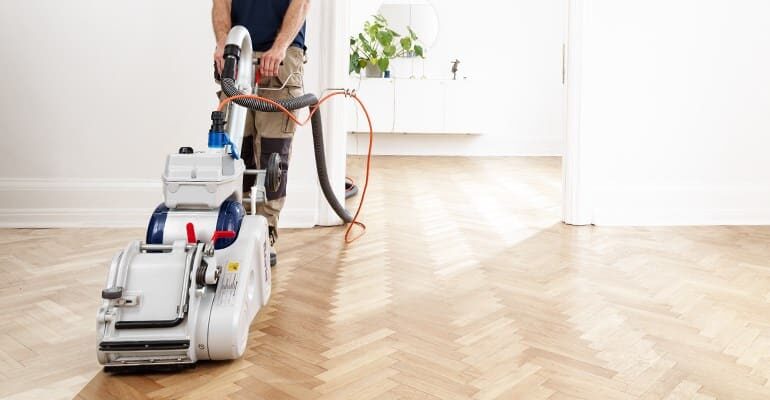London:
Nationwide:
The Dangers of Over-Sanding Your Deck
Posted on December 7, 2023
Wood Floor Sanding
Understanding the Risks of Excessive Deck Sanding: A Complete Overview
A well-maintained deck is more than just an aesthetic addition to your home; it’s a haven for relaxation and a stage for memorable outdoor gatherings. However, the beauty and functionality of a deck heavily depend on regular and proper maintenance. This introduction aims to shed light on the crucial aspects of deck care, focusing on the balance between preservation and aesthetic appeal.
Your deck battles the elements daily, from the scorching sun to relentless rain and even the occasional snowfall. These conditions take a toll, gradually wearing down its resilience and appearance. Regular maintenance is key to extending the life of your deck and ensuring it remains a safe and enjoyable space. This involves cleaning, inspecting for damage, making necessary repairs, and applying protective finishes.
One of the pivotal maintenance practices is sanding. Sanding is essential for preparing the deck for staining or sealing, removing splinters, and creating a smooth surface. However, it’s a delicate process that, if overdone, can lead to more harm than good. Over-sanding can weaken the wood, lead to uneven surfaces, and make the deck more susceptible to environmental damage.
This blog post delves into the nuances of deck sanding, highlighting the dangers of overdoing it. We will guide you through understanding the sanding process, recognising the signs of over-sanding, and embracing best practices to avoid potential damage. Whether you’re a seasoned DIY enthusiast or a first-time deck owner, this guide aims to equip you with the knowledge to maintain your deck effectively, ensuring it remains a cherished part of your home for years to come.
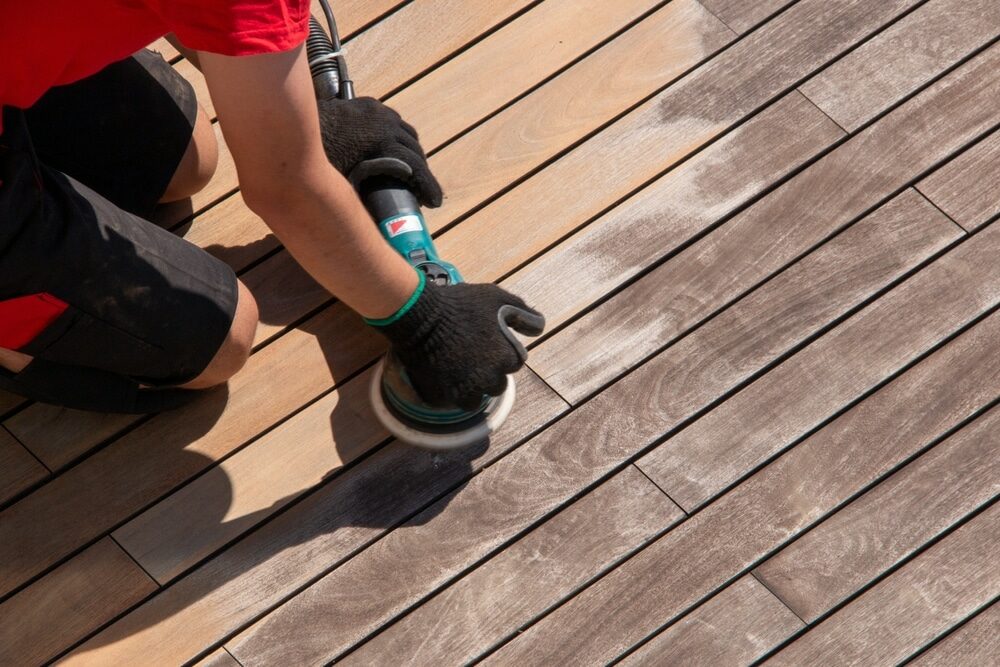
Understanding Sanding: The Basics
Sanding is a process used to smooth or alter the texture of your deck’s wooden surface. It involves using abrasive materials, such as sandpaper, to remove the top layer of wood, revealing a fresh layer beneath. This process is crucial for several reasons, including preparing the wood for new paint or stain, smoothing out rough or damaged areas, and removing old finishes or splinters.
Sanding tools and materials
- Sandpaper and Grits: The primary tool for sanding is sandpaper, which comes in various grits. The grit number indicates the size of the abrasive particles on the paper; the lower the number, the coarser the sandpaper. For deck sanding, a range of grits might be used, starting with a coarser grit for initial sanding and finishing with a finer grit for a smooth finish.
- Sanding Tools: Sanding can be done manually with hand-held sandpaper or with power tools like orbital sanders, belt sanders, or sanding blocks. Each tool offers different levels of control and efficiency. Hand sanding gives more precision but is labour-intensive, while power tools make the job quicker but require a steady hand to avoid over-sanding.
- Safety Equipment: Safety is paramount in sanding projects. Always wear protective gear, including safety goggles, a dust mask, and gloves. Sanding produces a lot of dust, which can be harmful if inhaled and irritating to the eyes and skin.

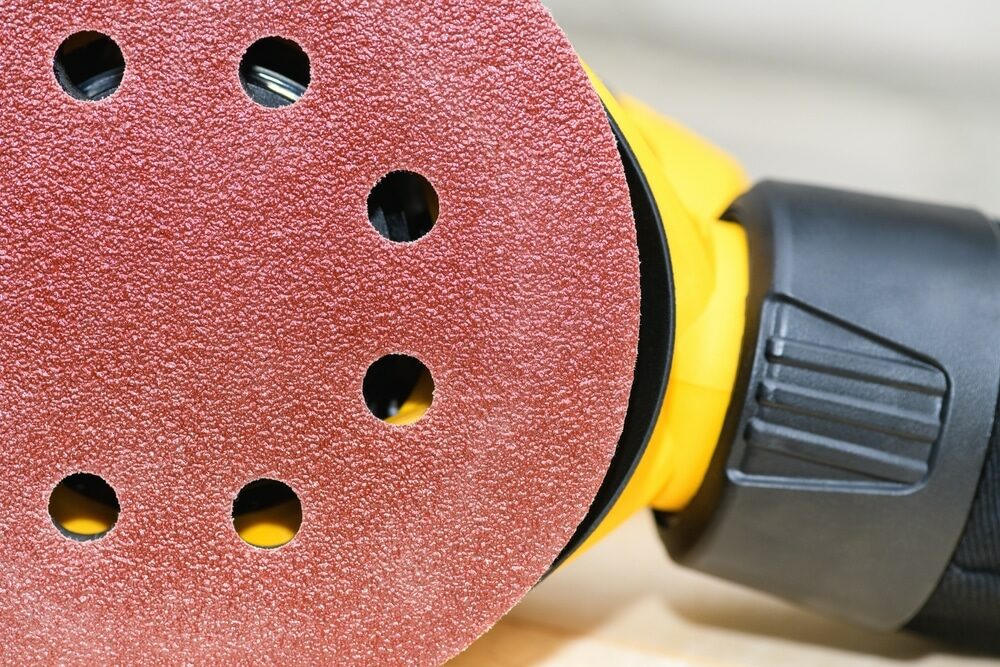
The sanding process
- Preparation: Before you start sanding, ensure your deck is clean and dry. Remove any furniture or obstacles, and fix any loose boards or protruding nails.
- Choosing the Right Grit: Start with a coarser grit to remove old finishes or significant roughness. Gradually move to finer grits to smooth the surface. The final grit choice depends on the type of finish you’ll be applying afterward.
- Technique: Use even, controlled motions when sanding. For manual sanding, work along the wood grain, not against it, to avoid scratches. With power tools, keep the sander moving to avoid gouging the wood.
- After Sanding: Once sanding is complete, thoroughly clean the deck to remove all dust. This can be done with a broom or a leaf blower. Some prefer to wash the deck down and let it dry before applying any finishes.

The Purpose of Sanding Your Deck
Sanding is not just a preparatory step in deck maintenance; it’s a critical process that serves multiple purposes, each contributing to the longevity and beauty of your deck. Understanding these purposes helps in executing the sanding process more effectively and judiciously.
1. Preparing for staining or sealing
- Enhances Adhesion: Sanding smooths the wood surface, providing an ideal texture for stains and sealants to adhere properly.
- Even Absorption: A sanded surface allows for uniform absorption of stains and sealants, ensuring a consistent finish that enhances the wood’s natural beauty.
2. Smoothing rough surfaces
- Safety and Comfort: Regular foot traffic and outdoor elements can leave the wood rough and splintered. Sanding smooths these imperfections, making the deck safer and more comfortable to walk on.
- Aesthetic Appeal: A smooth deck is not only pleasant to the touch but also more visually appealing. It reflects care and attention to detail.
3. Removing old finishes and damages
- Renewal of Wood Surface: Over time, old paint or stains may peel, crack, or fade. Sanding removes these old layers, revealing the fresh wood beneath.
- Repair Preparation: For decks with mildew, weather damage, or other surface-level issues, sanding is often the first step in the repair process. It clears the way for further treatments like filling cracks or applying preservatives.
4. Enhancing Wood Grain
- Highlighting Natural Beauty: Proper sanding can accentuate the natural grain of the wood, bringing out its unique patterns and textures.
- Personalisation: Through various sanding techniques, you can achieve different finishes that personalise the look of your deck.
5. Long-term Maintenance
- Extends Deck Life: By regularly removing the worn-out upper layer of wood, sanding can prolong the overall lifespan of your deck.
- Preventive Care: Regular sanding can prevent larger issues like rot and deep cracks by addressing minor damages early.
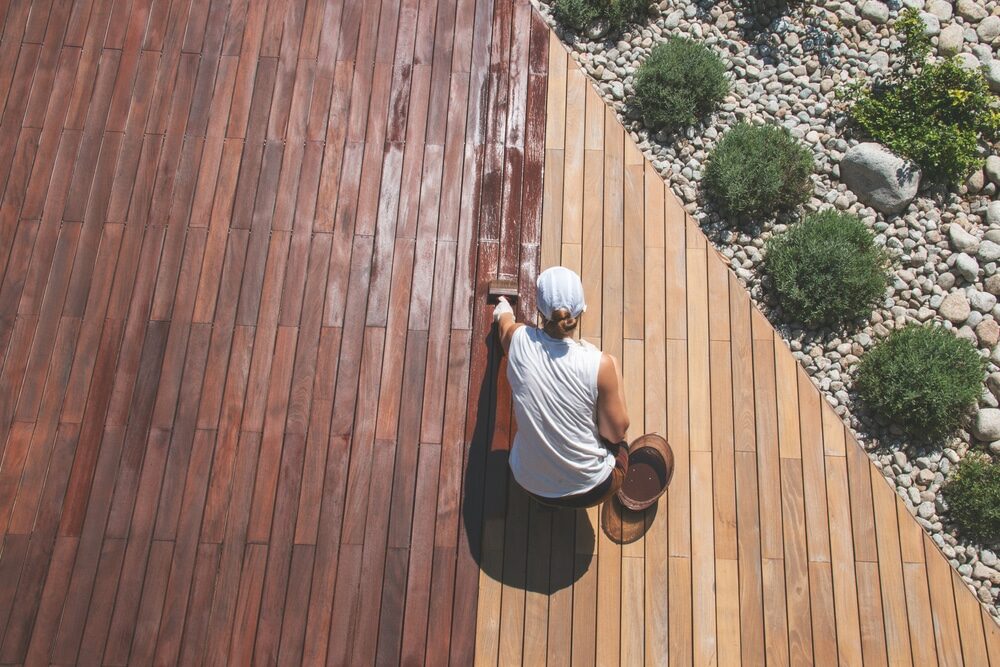
Risks of Over-Sanding
While sanding is an essential maintenance step for your deck, overdoing it can lead to several problems. Understanding these risks is crucial for maintaining the integrity and longevity of your deck.
1. Weakening the wood structure
- Thinning of Wood: Excessive sanding can reduce the thickness of the deck boards, compromising their structural integrity.
- Increased Fragility: Over-sanded wood becomes more fragile, making it more susceptible to cracking or breaking under pressure.
2. Creating Uneven Surfaces
- Gouging and Dips: Overuse of power sanders or uneven pressure can create gouges or dips in the wood, leading to an uneven surface.
- Irregular Wood Grain Exposure: Over-sanding can expose uneven wood grain, leading to an inconsistent appearance and texture.
3. Increased vulnerability to weather damage
- Reduced Protection: Thinner wood has less capacity to withstand environmental stressors like UV rays, moisture, and temperature fluctuations.
- Moisture Penetration: Over-sanded wood is more prone to absorbing moisture, which can lead to warping, swelling, or rot.
4. Difficulty in Staining or Sealing
- Uneven Absorption: An over-sanded surface may absorb stains and sealants unevenly, leading to blotchy or inconsistent finishes.
- Adhesion Problems: Extremely smooth or polished surfaces, a result of over-sanding, can hinder the adhesion of finishes.
5. Cost- and labour-intensive repairs
- Frequent Maintenance: Decks that have been over-sanded may require more frequent maintenance and repairs.
- Expensive Restorations: In severe cases, portions of the deck may need to be replaced entirely, which can be costly.
6. Environmental Impact
- Waste of Material: Over-sanding reduces the lifespan of wood, leading to premature waste and replacement.
- Increased Carbon Footprint: More frequent repairs and replacements indirectly contribute to a higher carbon footprint.
Recognising the Signs of Over-Sanding
Over-sanding can compromise the integrity and beauty of your deck. Being able to recognise the signs of oversanding is crucial to taking corrective measures and preventing further damage. Here are key indicators to watch out for:
1. Visual Indicators
- Uneven Surface: Look for dips, valleys, or uneven areas where the sander may have lingered too long.
- Excessive Smoothness: A surface that feels too smooth to the touch, almost like polished furniture, can be a sign of oversanding.
- Thinned Boards: Noticeably thinner or frail-looking boards are a clear sign of excessive material removal.
2. Texture Changes
- Splintering or Fraying Edges: If the edges of the boards start to splinter or fray, it could indicate that the wood fibres have been weakened due to over-sanding.
- Loose Wood Fibres: Over-sanded wood may exhibit a fuzzy texture with loose fibres on the surface.
3. Long-term Effects on Wood
- Increased Absorption of Moisture: If the deck seems to absorb water more quickly than usual after rain or cleaning, it might be due to the loss of protective layers through over-sanding.
- Rapid Colour Fading: Over-sanded wood may not hold stains or paints as well, leading to rapid fading or uneven coloration.
4. Application Issues with Finishes
- Blotchy Staining: Uneven absorption of stain, leading to a blotchy appearance, can be a consequence of over-sanding.
- Poor Adhesion of Sealants: If sealants or paints peel off or do not adhere properly, it could be due to the overly smooth surface created by over-sanding.
5. Structural Weakness
- Creaking or Flexing: If the deck boards creak more than usual or flex under weight, it might be a sign that they have been weakened by over-sanding.
- Visible Wear Under Light Traffic: Quick wear or damage from light usage can indicate that the deck’s resilience has been compromised.
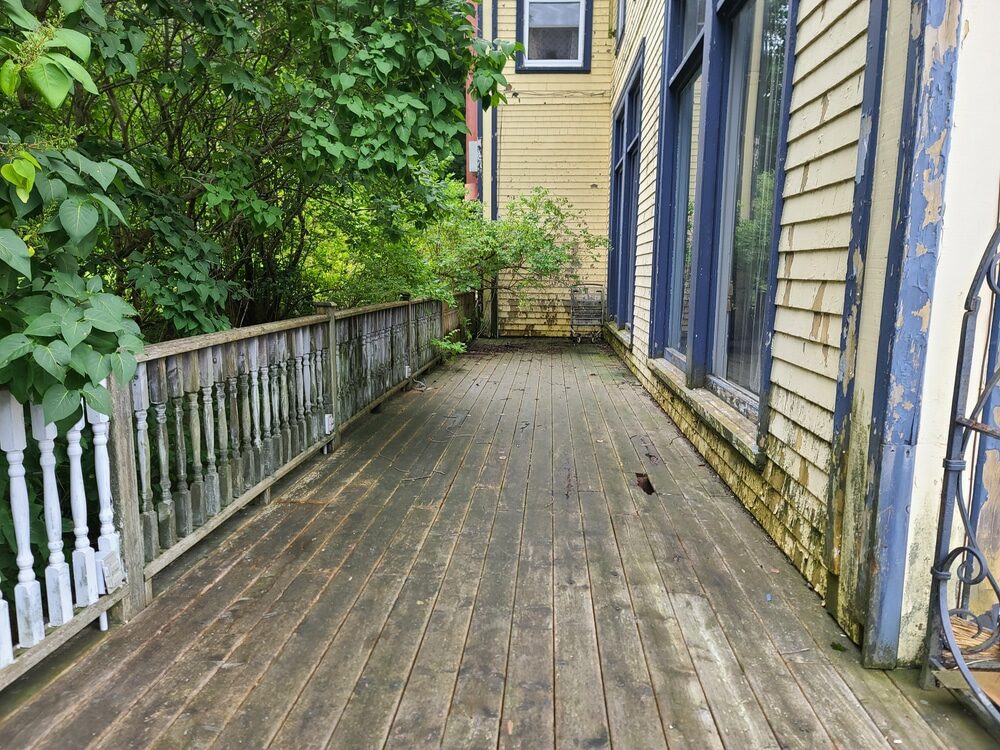
Best Practices for Safe and Effective Sanding
Sanding your deck is a delicate balance between improving its appearance and maintaining its integrity. Adhering to best practices ensures you achieve the desired results without causing damage. Here are essential guidelines for safe and effective sanding:
1. Choosing the Right Sandpaper Grit
- Start with Coarser Grits: Begin with a coarser grit (around 60–80) to remove old finishes and major imperfections. Avoid starting with very coarse grits, as they can cause deep scratches.
- Gradually Move to Finer Grits: Progressively switch to finer grits (100–120) to smooth the surface. Finishing with a fine grit (150–180) prepares the deck for staining or sealing.
2. Techniques for even sanding
- Follow the grain: Always sand in the direction of the wood grain to avoid scratches and ensure a smooth finish.
- Even Pressure: Apply consistent pressure while sanding. Avoid pressing too hard or lingering in one spot, especially with power sanders.
- Keep Moving: With power sanders, keep the tool moving to prevent gouging the wood. For hand-sanding, use long, even strokes.
3. Knowing when to stop
- Visual Inspection: Regularly check the surface for evenness and smoothness. Stop sanding when you’ve achieved a uniformly smooth surface without removing too much material.
- Feel the Surface: Run your hand over the sanded area to feel for any rough spots or inconsistencies.
4. Safety Precautions
- Wear protective gear: Always use safety goggles, a dust mask, and gloves to protect against wood dust and splinters.
- Proper Ventilation: Ensure good ventilation when sanding, especially if using a power sander, to avoid dust accumulation.
5. Post-Sanding Cleanup
- Thorough Cleaning: After sanding, thoroughly clean the deck to remove all dust and debris. Use a leaf blower, a soft broom, or a vacuum designed for wood dust.
- Final Inspection: Before applying any finish, inspect the deck one last time to ensure it’s completely clean and smooth.
6. Mind the weather
- Ideal Conditions: Sand your deck in dry weather. Moisture can affect the wood and the efficiency of the sanding process.
7. Regular maintenance checks
- Routine Inspections: Regularly inspect your deck for signs of wear and tear. Timely maintenance can reduce the need for extensive sanding.
8. Learning from experience
- Practice Makes Perfect: If you’re new to sanding, consider practicing on a less visible area or a spare piece of wood to get a feel for the process.
Alternatives to Over-Sanding
Over-sanding can compromise the structural integrity of your deck. Fortunately, there are alternative methods to maintain and refurbish your deck without relying heavily on sanding. These alternatives can be effective in keeping your deck in top condition while minimising risks.
1. Chemical strippers and cleaners
- Purpose: These products are designed to remove old finishes, stains, and mild paint from wood surfaces without the abrasiveness of sanding.
- Application: Apply the stripper or cleaner as per the manufacturer’s instructions, usually with a brush or roller.
- Safety Measures: Wear protective gloves, goggles, and a mask, as these chemicals can be harsh.
2. Pressure Washing Considerations
- Effective Cleaning: Pressure washing can remove dirt, mildew, and loose paint without damaging the wood’s surface.
- Caution Needed: Use a low- to medium-pressure setting to avoid damaging the wood. Keep the nozzle moving to prevent it from gouging.
3. Scraping and scratching
- Manual Scraping: For peeling paint or finishes, a manual scraper can be used gently to remove the loose material.
- Scuff Sanding: Instead of extensive sanding, a light scuff sanding can be done to roughen up the surface for better adhesion to the new finish.
4. Hiring professional services
- Expertise: Professionals have the experience and equipment to handle deck maintenance with minimal risk of damage.
- Consultation: Professionals can provide advice on the best approach for your deck’s condition and recommend treatments.
5. Regular cleaning and maintenance
- Routine Cleaning: Regular cleaning with appropriate wood cleaners can prevent buildup and reduce the need for aggressive treatments.
- Regular Inspections: Periodic checks for damage or wear can help address issues before they require major interventions like sanding.
6. Revitalising Products
- Wood brighteners and revitalizers: These products can restore the look of your deck without aggressive sanding. They are designed to enhance the wood’s natural beauty and are usually easy to apply.
7. Sealants and Stains for Protection
- Protective Coatings: Using high-quality sealants and stains can protect the wood from environmental damage, reducing the need for frequent sanding.
8. Use of Deck Pads or Mats
- Surface Protection: Placing protective pads or mats in high-traffic areas can reduce wear and tear on the deck surface.
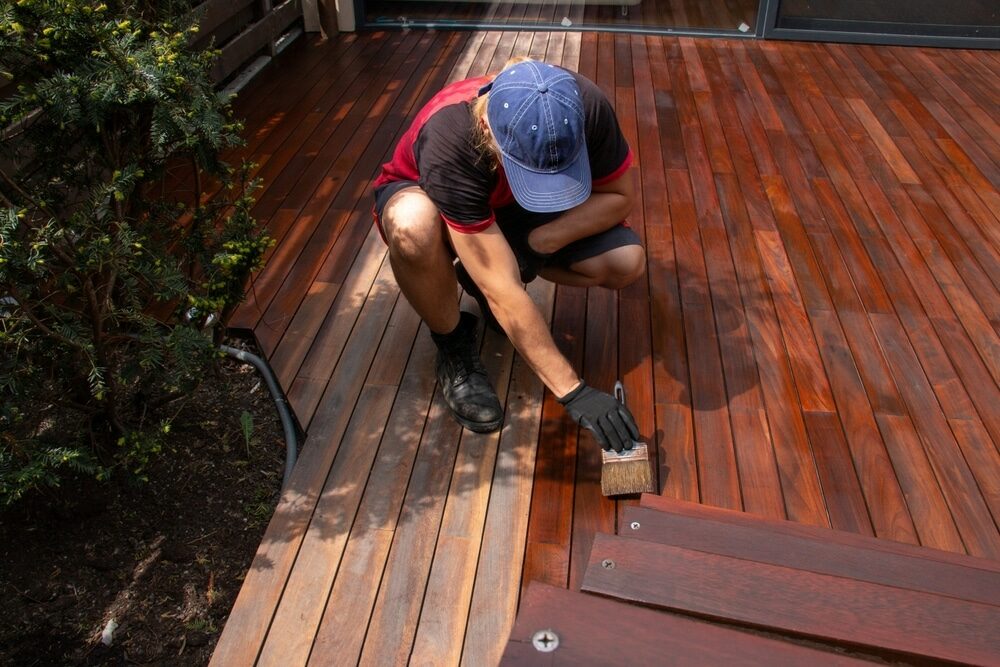
Alternatives to Over-Sanding
Over-sanding can weaken your deck’s wood and cause unnecessary wear. Fortunately, there are effective alternatives to maintaining your deck that minimise or eliminate the need for extensive sanding. Here are some methods:
1. Chemical strippers and cleaners
- Function: These products are designed to remove old finishes, stains, and some types of paint without the need for abrasive sanding.
- Application: Apply as per the manufacturer’s instructions, using a brush or roller, and allow it to work on the surface before rinsing or scraping it off gently.
- Safety Precautions: Always wear protective gear, like gloves and goggles, as these chemicals can be harsh and potentially harmful.
2. Pressure Washing
- Effective Cleaning Method: A pressure washer can clean your deck thoroughly, removing dirt, grime, and loose paint.
- Caution: Use a lower pressure setting to prevent damaging the wood. Keep the nozzle moving and at a safe distance to avoid etching or gouging the wood.
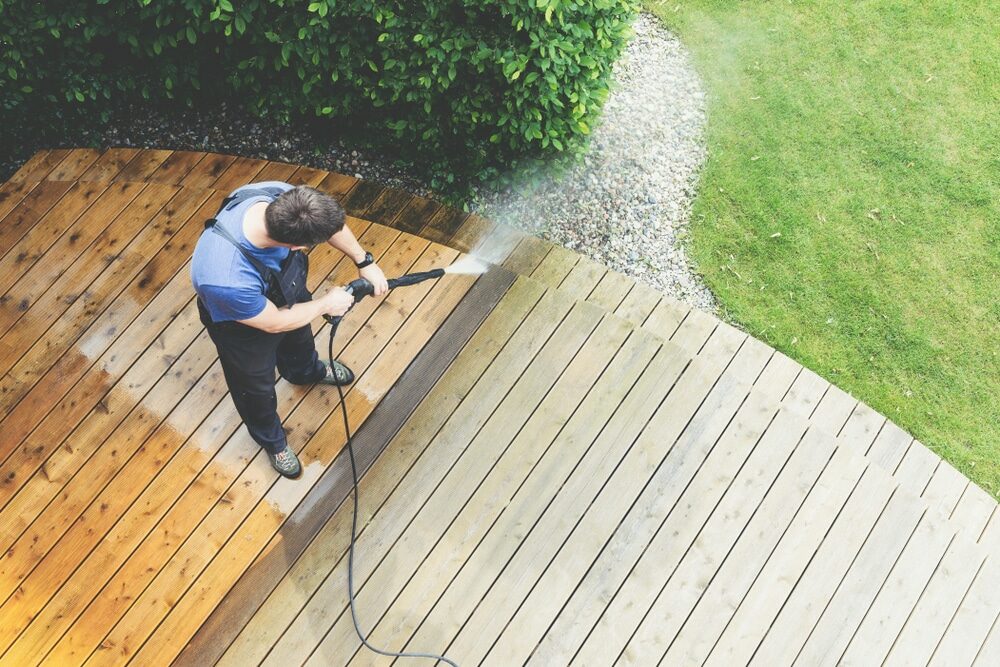
3. Hand scraping and gentle abrasives
- Manual Scraping: For flaking or peeling paint, gentle scraping can be effective.
- Light Abrasive Pads: Use fine steel wool or a light abrasive pad for minor touch-ups, especially in areas with delicate wood or intricate designs.
4. Professional Services
- Expertise on Call: Sometimes, calling in professionals is the best option, especially if the deck requires more complex care.
- Consultation: Professionals can assess the condition of your deck and suggest the best course of action, which may not involve heavy sanding.
5. Regular cleaning and maintenance
- Routine Care: Regularly cleaning your deck with appropriate wood cleaners can prevent the buildup of grime and mildew, reducing the need for heavy maintenance.
- Inspections: Regularly inspecting your deck for minor issues can prevent them from escalating into problems that require sanding.
6. Using revitalizers and brighteners
- Wood Treatments: Specialised products can refresh the look of your deck and enhance the wood’s natural beauty without sanding.
- Application: These are typically easy to apply and can restore the wood’s appearance.
7. Sealants and stains
- Protective Coating: Quality sealants and stains can shield the wood from environmental damage, reducing the frequency of intense maintenance.
8. Deck pads or mats
- Surface Protection: In high-traffic areas, consider using protective pads or mats to reduce direct wear on the deck.
Repairing an Oversanded Deck
If your deck has been over-sanded, it’s important to address the issue promptly to prevent further damage and restore its appearance and integrity. Here’s a step-by-step guide to repairing an over-sanded deck:
1. Assessing the damage
- Examine the deck: Carefully inspect the deck to determine the extent of the damage. Look for signs like thinning wood, uneven surfaces, or excessive smoothness.
- Identify Structural Weaknesses: Pay special attention to any areas that might have become structurally weak or unstable due to over-sanding.
2. Steps for Repair and Restoration
- Fill Gouges and Uneven Areas: Use a wood filler or putty to fill in any gouges, dips, or uneven areas. Ensure the filler is suitable for exterior use and matches the type of wood on your deck.
- Light Sanding for Consistency: Once the filler is dry, perform light sanding to smooth out the filled areas and create a uniform surface. Use fine-grit sandpaper and be gentle to avoid further thinning of the wood.
- Stabilise Loose Boards: If over-sanding has led to loose or unstable boards, secure them with new fasteners or replace them if necessary.
- Apply Restorative Treatments: Consider using a wood hardener or conditioner to reinforce weakened wood fibres and restore some of the deck’s structural integrity.
3. Preventative Measures for Future Maintenance
- Apply a Protective Finish: Once repairs are complete, apply a high-quality sealant or stain to protect the deck from moisture and UV damage. This also helps in hiding minor imperfections caused by oversanding.
- Regular Maintenance Checks: Establish a routine for inspecting and maintaining your deck. This includes cleaning, checking for damage, and applying protective treatments as needed.
4. Seeking professional help
- Consultation: If the damage is extensive or if you’re unsure about how to proceed, it might be best to consult a professional. They can provide expert advice and services to properly restore your deck.
5. Long-Term Care
- Gentle Cleaning: Use mild cleaners and soft brushes for regular cleaning to avoid further wear on the wood.
- Avoid Repeated Sanding: In future maintenance, be cautious with sanding and only do it when absolutely necessary.
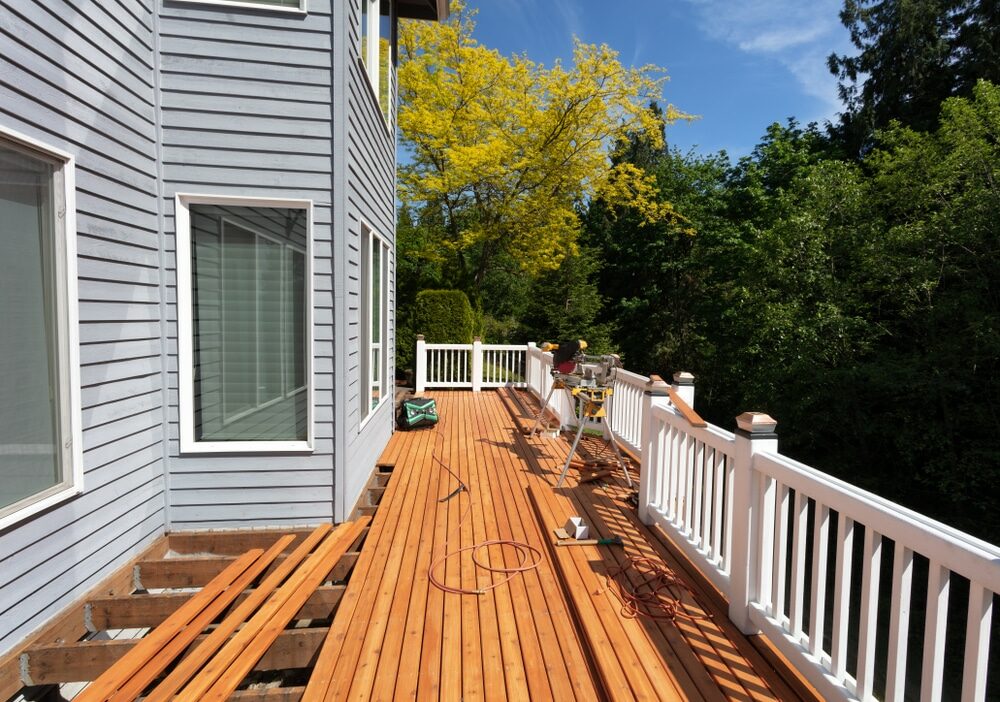
Conclusion: Balancing Maintenance and Preservation
The journey of maintaining your deck is a delicate dance between preserving its structural integrity and enhancing its aesthetic appeal. This balance is pivotal in ensuring that your deck not only looks inviting but also remains a safe and durable outdoor space for years to come.
Key Takeaways:
- The importance of regular maintenance
- Regular upkeep, including cleaning, inspecting for damage, and applying protective finishes, is crucial for prolonging the life of your deck.
- Timely maintenance helps in avoiding more drastic measures like heavy sanding or extensive repairs.
- Understanding the Role of Sanding
- Sanding is a valuable tool in deck maintenance but should be approached with caution. It’s meant to prepare the surface for treatments and smooth out minor imperfections, not to drastically reduce the wood’s thickness or alter its fundamental structure.
- Risks of Over-Sanding
- Over-sanding can weaken the wood, create uneven surfaces, and make the deck more susceptible to environmental damage. Recognising the signs of oversanding is essential to preventing and addressing these issues.
- Embracing Alternatives
- Exploring alternatives to sanding, such as using chemical strippers, pressure washing, or applying revitalizers, can be equally effective in maintaining your deck without the risks associated with over-sanding.
- Repairing and Restoring Over-Sanded Decks
- In cases where over-sanding has occurred, prompt and appropriate measures like filling, light sanding, and applying restorative treatments can salvage the situation.
- Consulting professionals when needed
- Seeking professional advice or services is a wise step, especially when faced with complex maintenance issues or extensive damage.
- Commitment to Sustainable Practices
- Deck maintenance is not just about immediate appearance; it’s a commitment to sustainable practices that ensure the deck remains a cherished aspect of your home for a long time.
In conclusion, effective deck maintenance is about striking the right balance. It’s about understanding the needs of your deck, responding to them appropriately, and always keeping in mind the fine line between maintenance and preservation. With this balanced approach, your deck will continue to be a source of pride and pleasure for many years.

Sanding
We provide virtually dust-free sanding with our continuous belt machinery with mobile extraction units, giving you a safer environment for your family.
Oiling
This organic finish not only adds beauty to your home but also has exceptional water-repellent characteristics, making it easier to clean and maintain.
Waxing
This natural floor finish offers the softest and most mellow appearance – and leaves your floor able to breath.
Buffing
Using soft buffing machines (and hand-polishing where required) will bring a wonderful sheen to your newly-finished floor.
Repairs
We offer a full assessment of your wooden floors to determine what repairs are needed to provide the perfect working surface for the later stages of sanding, staining and sealing.
Restoration
We offer a comprehensive restoration process designed to address floors that are improperly fitted or damaged over time through wear and tear.
Request a fixed price quote for your wood floor restoration now
Simply enter your postcode below to get started.
Services
Wood Floor Sanding Wood Floor Restoration Wood Floor Scratch Repair Squeaky Wood Floor Repair Parquet Floor Sanding Parquet Floor Restoration Commercial Floor Sanding Church Floor Sanding Community Centre Floor Sanding School Floor Sanding Gap Filling Gap Filling with ResinCopyright © Mr Sander®
Privacy & Cookies Terms & Conditions Complaints Procedure Cancellation Rights Sitemap

